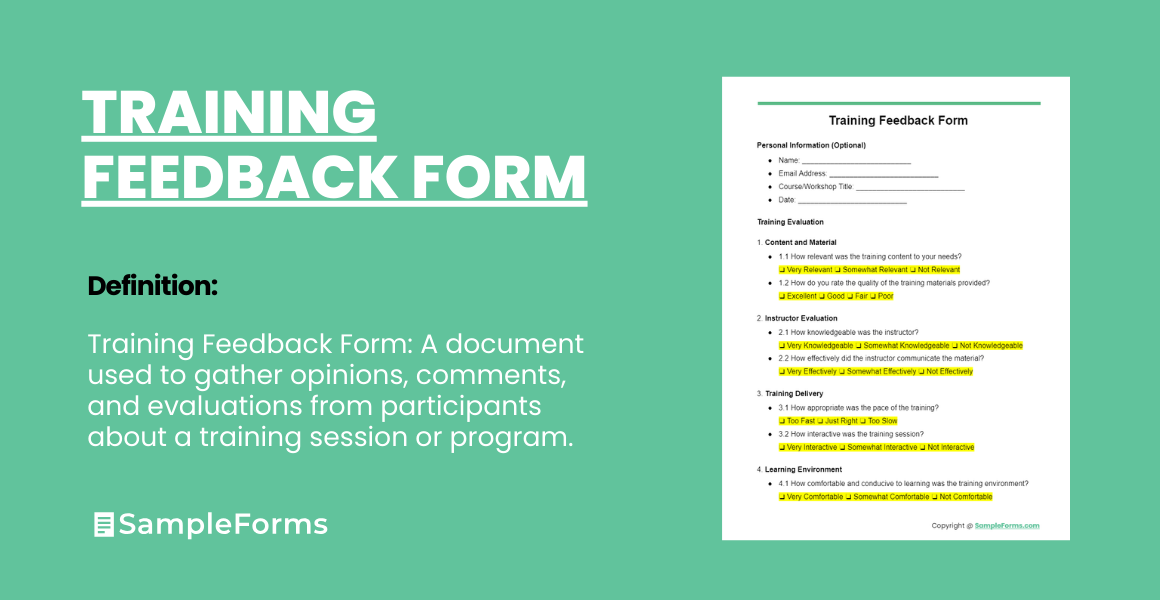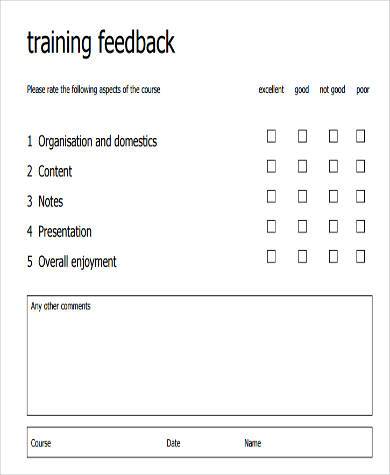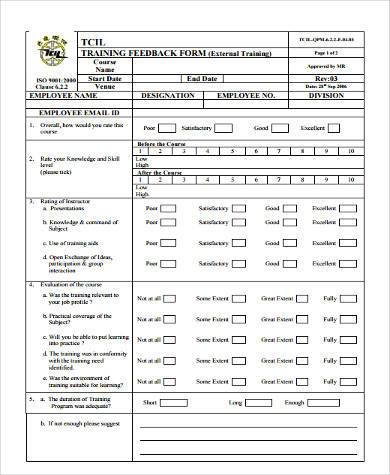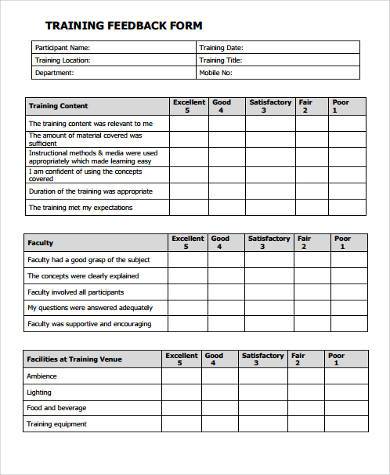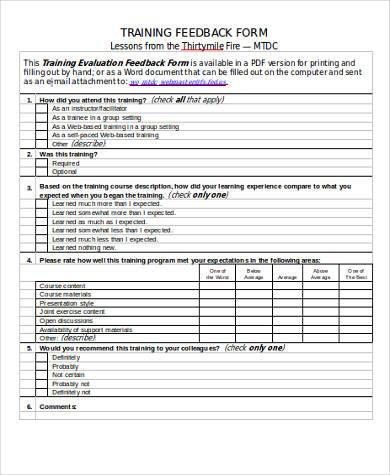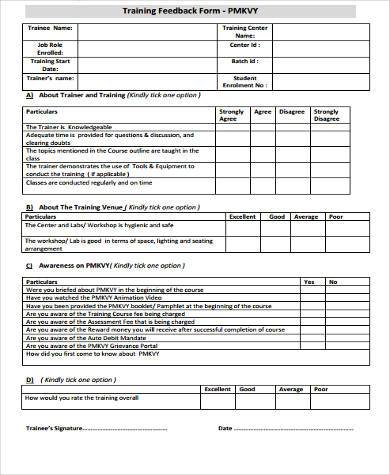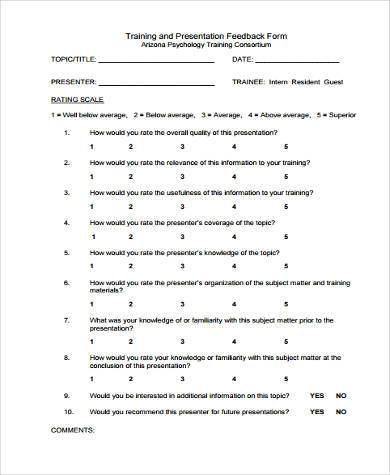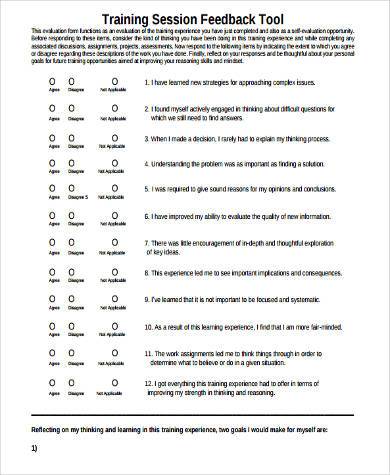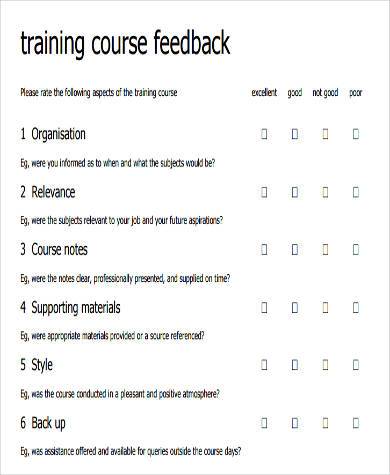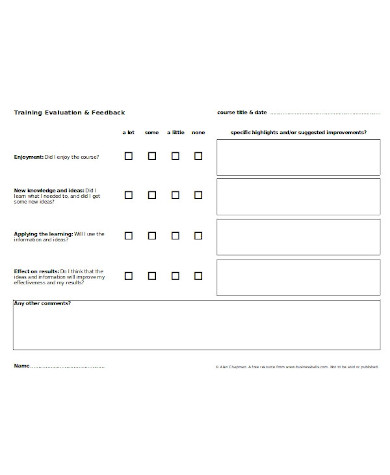Dive into our complete guide on Training Feedback Forms and unlock the potential of effective feedback collection. Whether you’re looking to gauge student satisfaction, employee learning, or customer experience, our guide provides you with Sample Feedback Form and Fillable Form to gather valuable insights. Offers step-by-step examples, making it easier than ever to implement a comprehensive feedback system. With our guide, creating impactful and actionable feedback forms is within reach.
Download Training Feedback Form Bundle
What is the Training Feedback Form?
A Training Feedback Form is a tool used to evaluate the effectiveness of a training session. It gathers participants’ opinions on various aspects of the training, including content relevance, presentation style, trainer expertise, learning outcomes, and the overall training environment. This form allows trainers to receive constructive feedback, identify areas of strength, and pinpoint aspects needing improvement. By analyzing the responses, organizations can refine their training programs, enhance the learning experience, and ensure that the training objectives are met. The feedback collected is crucial for the continuous development of training strategies and for maximizing the return on investment in employee development initiatives.
The Best Sample Training Feedback Form(Copy & Paste)
Below is a sample template for a Training Feedback Form that can be used to gather participants’ opinions on a training session:
Training Feedback Form
Training Title: _______________________________________________________
Date: _______________________
Trainer’s Name: _______________________________________________________
Please rate the following aspects of the training:
- Content Relevance:
- Excellent
- Good
- Average
- Poor
- N/A
- Trainer’s Knowledge:
- Excellent
- Good
- Average
- Poor
- N/A
- Trainer’s Presentation Skills:
- Excellent
- Good
- Average
- Poor
- N/A
- Interaction and Participation:
- Excellent
- Good
- Average
- Poor
- N/A
- Training Materials Provided:
- Excellent
- Good
- Average
- Poor
- N/A
- Venue and Facilities:
- Excellent
- Good
- Average
- Poor
- N/A
- Overall Satisfaction:
- Excellent
- Good
- Average
- Poor
- N/A
What did you like most about the training?
What aspects of the training could be improved?
How will you apply what you have learned?
Additional Comments:
Would you recommend this training to others?
- Yes
- No
Participant’s Name (Optional): _________________________________________
Signature: _____________________________ Date: ___________________
This form should be distributed to participants after the training session to collect immediate feedback. It’s important to ensure that the form is anonymous to encourage honest and constructive responses, unless participant identification is necessary for follow-up or certification purposes.
Training Feedback Form Format
Training Title: ___________________________
Date: _______________
Instructor: _______________________________
Participant Information (Optional)
Name: ___________________________ (Optional)
Role/Position: ___________________________
Department: ___________________________
1. Training Content
- Was the content relevant and useful?
[ ] Strongly Agree [ ] Agree [ ] Neutral [ ] Disagree [ ] Strongly Disagree - How would you rate the depth of the content provided?
[ ] Excellent [ ] Good [ ] Average [ ] Below Average [ ] Poor
2. Instructor Evaluation
- How effectively did the instructor convey the material?
[ ] Strongly Agree [ ] Agree [ ] Neutral [ ] Disagree [ ] Strongly Disagree - Was the instructor knowledgeable and responsive to questions?
[ ] Strongly Agree [ ] Agree [ ] Neutral [ ] Disagree [ ] Strongly Disagree
3. Training Delivery
- How do you rate the overall delivery and presentation of the training?
[ ] Excellent [ ] Good [ ] Average [ ] Below Average [ ] Poor - Was the training interactive and engaging?
[ ] Strongly Agree [ ] Agree [ ] Neutral [ ] Disagree [ ] Strongly Disagree
4. Training Materials
- Were the training materials helpful and appropriate?
[ ] Strongly Agree [ ] Agree [ ] Neutral [ ] Disagree [ ] Strongly Disagree - How would you rate the quality of training materials provided?
[ ] Excellent [ ] Good [ ] Average [ ] Below Average [ ] Poor
5. Overall Satisfaction
- How satisfied are you with the training you received?
[ ] Very Satisfied [ ] Satisfied [ ] Neutral [ ] Dissatisfied [ ] Very Dissatisfied - Would you recommend this training to others?
[ ] Definitely Yes [ ] Probably Yes [ ] Not Sure [ ] Probably No [ ] Definitely No
6. Open-Ended Feedback
- What did you like most about the training?
- What aspects of the training could be improved?
- Any other comments or suggestions?
Thank You for Your Feedback!
Training Feedback Form Template

Discover templates for Parent Feedback Form and Customer Feedback Form, designed to capture detailed insights from a wide audience. These templates are versatile, allowing for customization to fit specific training needs.
Training Feedback Form for student
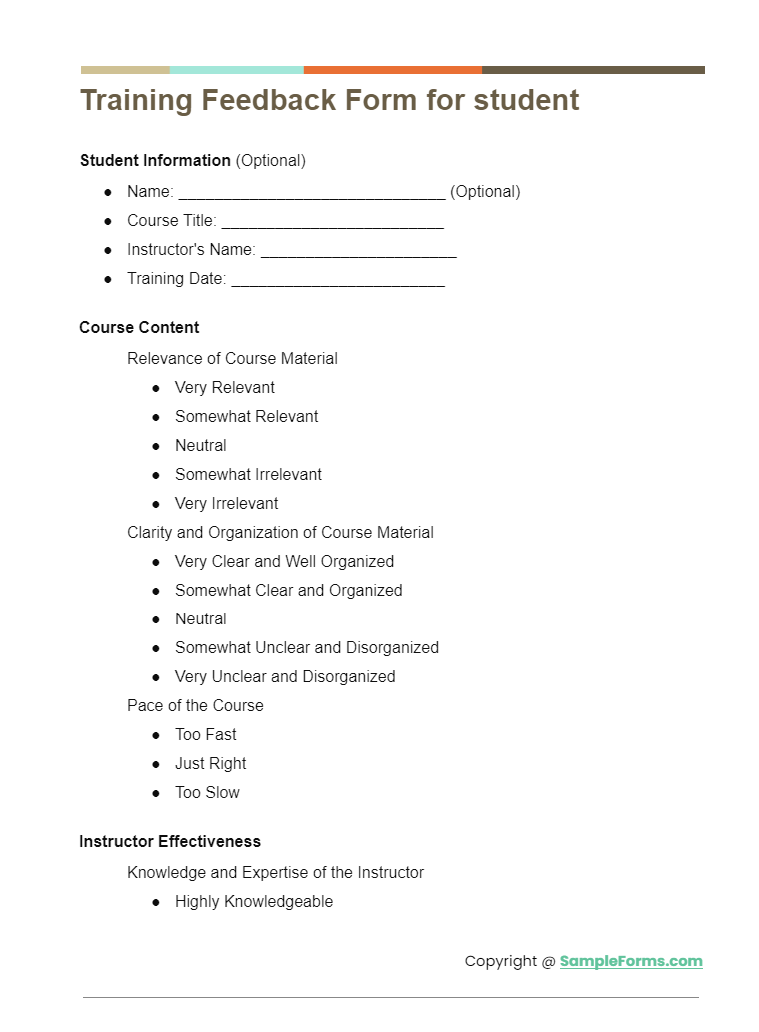
Incorporate Service Feedback Form and Teacher Feedback Form into your educational strategies to understand student experiences better and improve teaching methods.
Training Feedback Form for Employee

Enhance your corporate training programs with Workshop Feedback Form and Course Feedback Form. Tailored to gather employee insights, these tools are pivotal for professional development.
Training Feedback Form Questions
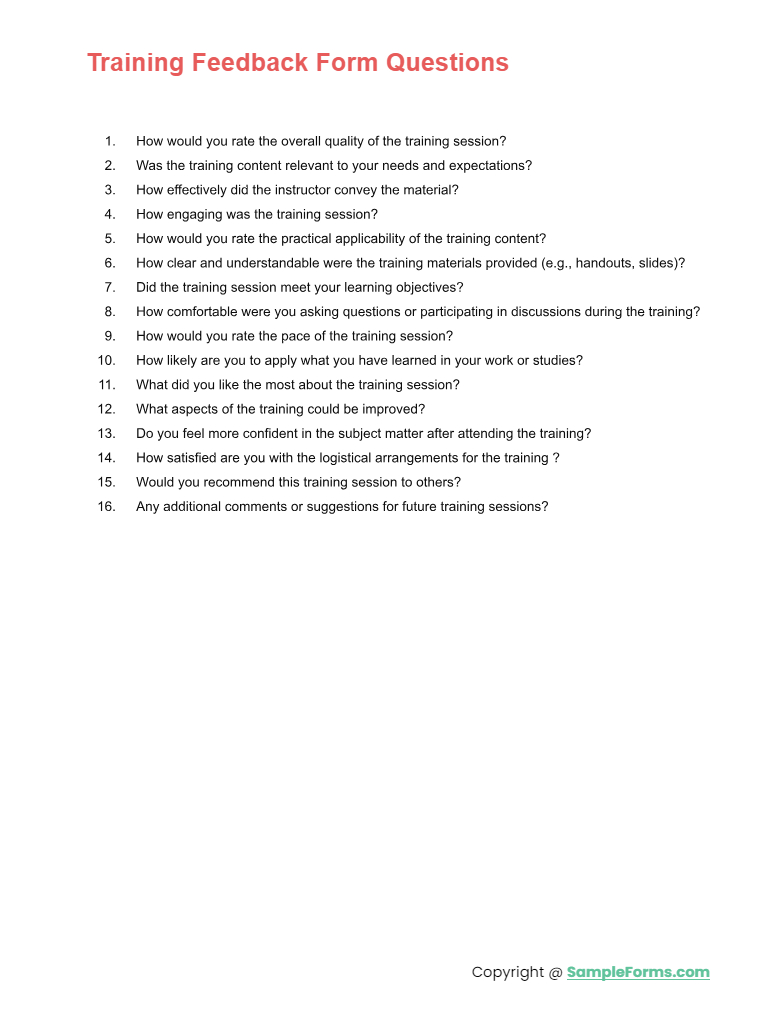
More Training Feedback Form Samples
Sample Training Feedback Form
Employee Training Feedback Form Example
Training Feedback Form PDF
Training Feedback Form in Doc
The Different Kinds of Feedback Forms
There are multiple kinds of Feedback Forms for training, but let’s look at the ones that are most commonly used.
- Employee Feedback Forms – These are for company owners, especially major ones, who need to know the feedback of their own employees, whether it’s about training or the workplace or any other factors that could improve their performance.
- Student Training Feedback Forms – For Schools that need to know if their students are doing well or not, this lets them see if they need to improve anything in their educational system so that they produce quality graduates.
- Training Session Feedback Forms – These are for those training sessions that people go through before they’re either hired or not. These let employers know whether or not their training method was helpful in any way.
Companies can keep things simple by handing out Printable Training Feedback Forms in either PDF or Word formats.
Student Training Feedback Form Format
Sample Training and Presentation Feedback Form
Training Session Feedback Tool Form
Sample Training Course Feedback Form
Standard Training Feedback Form
How do you Write a Feedback Form for Training?
Writing a feedback form for training involves understanding the specific needs and outcomes desired from the training session. For sectors like hospitality, including Hotel Feedback Form and Restaurant Feedback Form, it’s essential to focus on service quality, customer satisfaction, and operational efficiency. Similarly, an Employee Feedback Form should concentrate on job satisfaction, skill enhancement, and workplace environment. The key is to craft questions that are specific, measurable, and relevant to the training objectives, ensuring that the feedback collected is actionable and constructive.
How do you write a Training Evaluation Form?
Creating a Training Evaluation Form requires a strategic approach to assess the effectiveness of the training program accurately. For an Internship Feedback Form, include questions that evaluate the intern’s learning experience, skill development, and professional growth. A Student Feedback Form should gauge the educational impact, understanding of the subject matter, and the instructor’s effectiveness. Ensure the form includes both qualitative and quantitative questions, allowing for comprehensive evaluation. This approach helps in identifying strengths and areas for improvement in the training program.
How do you write a Feedback Report for a Training Program?
Writing a feedback report for a training program involves analyzing the collected data and presenting it in a way that highlights key findings, trends, and recommendations. Incorporating feedback from a Teacher Feedback Form can provide insights into instructional methods and content relevance. Similarly, a Manager Feedback Form can shed light on leadership effectiveness and team dynamics. The report should summarize the feedback, identify patterns, and suggest actionable steps for future training programs. This process ensures that the feedback is utilized constructively to enhance training outcomes.
What do you say in a Feedback Form?
In a feedback form, it’s crucial to encourage honest and specific feedback that can lead to meaningful improvements. For a Patient Feedback Form, questions should revolve around the quality of care, comfort, and overall experience. An Event Feedback Form should inquire about the attendee’s experience, event organization, and what aspects contributed to or detracted from their satisfaction. The form should be designed to elicit constructive criticism and positive feedback, allowing respondents to express their thoughts freely on what worked well and what could be improved. This approach ensures a balanced view that can be used to enhance future training sessions or events.
Why Training Feedback Is Important?
Training feedback is really important to a company hiring employees or universities that hand out specific courses to those that require them. These people who undergo the training should be able to give out open and concise feedback to the company or schools so that they’ll know whether or not they have to improve their training methods, or which specific aspects thereof may need to be improved upon. In addition, you should review our Course Feedback Forms.
How to Create the Training Feedback Form?
Creating a Training Feedback Form involves a thoughtful process to ensure you collect relevant and actionable data. Here’s a step-by-step guide to help you create an effective form:
- Define the Purpose: Determine what you want to learn from the feedback. Is it to assess the trainer’s effectiveness, the quality of the content, or the overall experience?
- Choose the Format: Decide whether the form will be digital or paper-based. Digital forms can be more efficient and easier to analyze.
- Design the Layout: Ensure the form is user-friendly. Group related questions together and use a clear, readable font.
- Select Question Types: Use a mix of question types:
- Rating Scales: For quantifiable feedback on specific aspects of the training.
- Open-Ended Questions: To allow for detailed responses and suggestions.
- Multiple Choice: For quick and easy responses on straightforward questions.
- Draft Clear Questions: Write questions that are direct and easy to understand to avoid confusion. Avoid leading questions that could bias the responses.
- Balance the Content: Include questions about different aspects of the training, such as the venue, materials, content relevance, and trainer effectiveness.
- Keep It Concise: A shorter form is more likely to be completed. Aim for a balance between gathering enough data and respecting the participants’ time.
- Pilot the Form: Test the form with a small group before using it to ensure the questions are clear and the form is easy to complete.
- Include Demographic Questions (if relevant): Sometimes, it’s useful to gather information about the participants, such as their department or role, to contextualize the feedback.
- Ensure Anonymity: If you want honest feedback, make sure participants know their responses will be anonymous.
- Add a Thank You Note: End the form with a thank you to the participants for their time and feedback.
- Review and Revise: After each training session, review the feedback and adjust the form as necessary to improve its effectiveness. You may also be interested to browse through our other Best Forms and Printable Forms
Tips for Effective Training Feedback Form
Related Posts
-
FREE 16+ Customer and Guest Feedback Forms in PDF | MS Word
-
FREE 6+ Market Research Forms in PDF | MS Word
-
FREE 3+ Feedback Observation Forms in PDF | MS Word
-
Classroom Observation Form
-
Behavior Observation Form
-
FREE 32+ Different Formats for Feedback Forms in PDF | Ms Word | Excel
-
FREE 11+ Property Feedback Forms in PDF | Ms word
-
FREE 11+ Observational Feedback Forms in PDF | MS Word
-
Nursing Feedback Form
-
Form for 360 Degree Feedback
-
FREE 10+ Feedback Forms Aimed at Doctors | PDF
-
FREE 11+ Demo Feedback Forms in PDF | MS Word
-
FREE 11+ Exam and Test Feedback Forms in PDF | Ms Word
-
FREE 10+ Medical Feedback Forms in PDF
-
Induction Feedback Form
